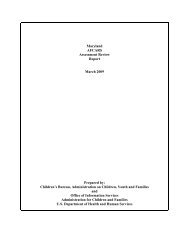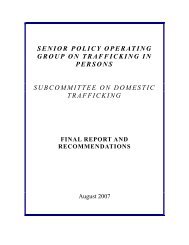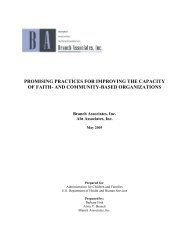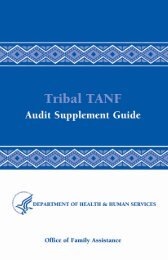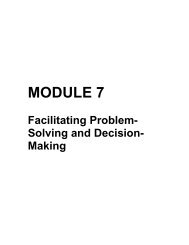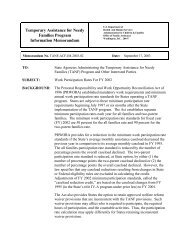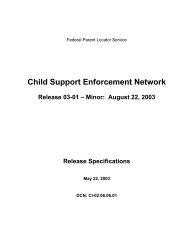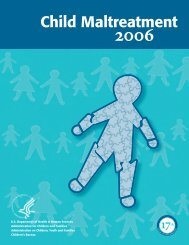Executive Summary Brochure - Administration for Children and ...
Executive Summary Brochure - Administration for Children and ...
Executive Summary Brochure - Administration for Children and ...
You also want an ePaper? Increase the reach of your titles
YUMPU automatically turns print PDFs into web optimized ePapers that Google loves.
Child Welfare Outcomes 2007–2010:Report to Congress<strong>Executive</strong> <strong>Summary</strong>NOW AVAILABLE!View the full Child WelfareOutcomes Report:http://www.acf.hhs.gov/programs/cb/pubs/cwo07-10/cwo07-10.pdfChild Welfare Outcomes2007–2010 includes:State data pages with:• Contextual data• Per<strong>for</strong>mance on originaloutcome measures• Per<strong>for</strong>mance on the CFSRcomposite measures• A State comment(if provided)A discussion of data issues<strong>and</strong> key findings of the dataanalyses across StatesSAFETYPERMANENCYWELL-BEINGThe Child Welfare Outcomes Reports are created by theU.S. Department of Health <strong>and</strong> Human Services (theDepartment) to meet requirements of section 203(a) of theAdoption <strong>and</strong> Safe Families Act of 1997 (ASFA). 1 ASFAamended section 479A of the Social Security Act (the Act) torequire an annual report that assesses State per<strong>for</strong>mance inoperating child protection <strong>and</strong> child welfare programs undertitles IV-B <strong>and</strong> IV-E of the Act. Child Welfare Outcomes 1998was the first report created in the Child Welfare Outcomesseries of reports. The present report, Child Welfare Outcomes2007–2010, is the eleventh report since the series’ inception.VISIT THE DATAWEBSITE!http://www.cwoutcomes.acf.hhs.gov/dataFor more in<strong>for</strong>mation on the Child WelfareOutcomes Data Site, see pages 10–11 of this<strong>Executive</strong> <strong>Summary</strong>.U.S. Department of Health <strong>and</strong> Human Services<strong>Administration</strong> <strong>for</strong> <strong>Children</strong> <strong>and</strong> Families<strong>Administration</strong> on <strong>Children</strong>, Youth <strong>and</strong> Families<strong>Children</strong>’s Bureau
Child Welfare Outcomes 2007–2010: Report to CongressCONTEXTUAL FACTORSThe Child Welfare Outcomes Report presentsdata on child welfare-related contextual factorsrelevant to underst<strong>and</strong>ing <strong>and</strong> interpreting Stateper<strong>for</strong>mance on the outcome measures. 2 Below isa summary of fiscal year (FY) 2010 data <strong>for</strong> thesecontextual factors. 3Characteristics of child victims• In 2010, 754,000 children were confirmedto be victims of maltreatment. 4 The overallnational child victim rate was 10.0 childvictims per 1,000 childrenin the population. 5 Statechild victim rates varieddramatically, ranging from1.3 child victims per 1,000children to 24.6 childvictims per 1,000 children. 6• The national child victim rate decreasedfrom 10.4 child victims per 1,000 childrenin the population in FY 2007 to 10.0 in FY2010. This is a continuation of a long-term,downward trend in the child victimization ratethat began in the early 1990s. 7Foster care in<strong>for</strong>mation overview• Nationally, there were approximately 415,000children in foster care on the last day of FY2010. During that year, an estimated 250,000children entered foster care, <strong>and</strong> 248,000children exited foster care. Among the States,the foster care entry rate ranged from 1.4children per 1,000 to 7.5 children per 1,000 ina State’s population. 8• Between FY 2002 <strong>and</strong> 2010, the numberof children in care on the last day of the FYdecreased by 22 percent. While currently itis not possible to determine the cause of thedecrease in the number of children in fostercare using the Adoption <strong>and</strong> Foster CareAnalysis <strong>and</strong> Reporting System (AFCARS)database, several States have made deliberateLonger range AFCARS data showthat, between FYs 2002 <strong>and</strong> 2010,the number of children in care onthe last day of the FY decreased by22 percent.ef<strong>for</strong>ts to safely reduce the number of childrenin care through various programmatic <strong>and</strong>policy initiatives. 9• Nationally, 213,000 children exited fostercare to a permanent home in 2010 (i.e., weredischarged to reunification, adoption, or legalguardianship). Of these 213,000 children,145,000 were discharged to reunification;52,000 were discharged to adoption; <strong>and</strong>16,000 were discharged to legal guardianship.In addition, 27,000 children wereemancipated from foster care in 2010. Therewere approximately 7,000 children who exitedcare <strong>for</strong> reasons other thanpermanency or emancipation,such as transfer to anotheragency or to another State.• Approximately 107,000children were waiting <strong>for</strong>adoption in 2010. 10STATE PERFORMANCE ON OUTCOMEMEASURESThe Child Welfare Outcomes Report presentsdata <strong>and</strong> analyses on seven outcome categories. Asynopsis of key findings <strong>for</strong> these outcome areasis provided below. The measures relevant to theseoutcomes are described in detail in appendix Bof the full report. Most of the outcome measuresalso are listed in tables 1 <strong>and</strong> 2 of this executivesummary. Note that individual measures that arepart of the Child <strong>and</strong> Family Services Reviews(CFSRs) permanency composites are preceded bya “C” to distinguish them from the original outcomemeasures. The original outcome measureswere developed prior to the first Child WelfareOutcomes Report (1998) in close consultationwith State representatives <strong>and</strong> other professionalsin the field. The composite measures, developedin 2005 <strong>and</strong> adopted in 2006, were based on thesame outcome goals, but were created in responseto requests that the Department measure moredetailed aspects of the original outcomes to allowa better underst<strong>and</strong>ing of State per<strong>for</strong>mance.2
http://www.acf.hhs.gov/programs/cb/pubs/cwo07-10/executive.pdfAll national medians <strong>for</strong> outcome measures referencedin this executive summary include onlythose States <strong>for</strong> which adequate data are available<strong>for</strong> FY 2007 through FY 2010. Tables of thesemedians can be found at the end of this executivesummary. 11Outcome 1: Reduce recurrence of childabuse <strong>and</strong>/or neglect• In 2010, State per<strong>for</strong>mance variedconsiderably with regard to the percentageof child victims experiencing a recurrence ofchild maltreatment within a 6-month period(measure 1.1) (range = 1.2 to 12.3 percent;median = 4.8 percent).• States with higher victim rates tended tohave higher maltreatmentrecurrence rates within a6-month period (Pearson’sr = .64). 12 In addition,consistent with previousChild Welfare OutcomesReports, States with arelatively high percentageof children who were victims of neglect (asopposed to other <strong>for</strong>ms of maltreatment) alsohad some tendency to have a relatively highpercentage of maltreatment recurrence withina 6-month period (Pearson’s r = .47).• Between 2007 <strong>and</strong> 2010, 63 percent of Statesdemonstrated improved per<strong>for</strong>mance withregard to the measure of recurrence of childmaltreatment (measure 1.1). In addition, themedian across States <strong>for</strong> this measure changedfrom 5.3 percent in 2007 to 4.6 percent in2010. Given that a lower recurrence rateis desirable, this demonstrates an overallimprovement in per<strong>for</strong>mance (a –13.2 percentchange in the median State). 13Outcome 2: Reduce the incidence of childabuse <strong>and</strong>/or neglect in foster care• In 2010, State per<strong>for</strong>mance regarding themaltreatment of children while in fosterIn many States, a large percentageof children who were emancipatedfrom foster care in 2010 were infoster care <strong>for</strong> long periods of timebe<strong>for</strong>e they were emancipated.care (measure 2.1) ranged from 0.00 to 2.33percent, with a median of 0.35 percent.• Between 2007 <strong>and</strong> 2010, 60 percent ofStates demonstrated improved per<strong>for</strong>mance.However, the median per<strong>for</strong>mance <strong>for</strong> thismeasure improved only slightly, from 0.35percent in 2007 to 0.34 percent in 2010.Outcome 3: Increase permanency <strong>for</strong>children in foster care• In 2010, States were fairly successful inachieving a permanent home <strong>for</strong> all childrenexiting foster care (measure 3.1, median= 86.8 percent). However, States were lesssuccessful in achieving permanent homes<strong>for</strong> children exiting foster care who had adiagnosed disability (measure3.2, median = 77.0 percent),<strong>and</strong> even less successful infinding permanent homes <strong>for</strong>children exiting foster care whoentered care when they wereolder than age 12 (measure3.3, median = 67.3 percent).• For children who had been in foster care <strong>for</strong>long periods of time (measure C3.1), definedat 24 months or longer, only 30.2 percent(median) of these children had permanenthomes by the end of 2010. Between 2007<strong>and</strong> 2010, 69 percent of States exhibitedan improvement in per<strong>for</strong>mance, <strong>and</strong> thenational median <strong>for</strong> this measure increasedfrom 26.4 percent to 30.2 percent.• States that were successful in achievingpermanency <strong>for</strong> children at the time ofexit from foster care (measure 3.1) alsowere successful in achieving permanency<strong>for</strong> children who are in foster care <strong>for</strong> longperiods of time (measure C3.1). This isdemonstrated by the fact that there is a strongpositive correlation (Pearson’s r = .70) betweenthese two measures.3
Child Welfare Outcomes 2007–2010: Report to Congress• In many States, a considerable percentage ofchildren who were emancipated from fostercare in 2010 were in foster care <strong>for</strong> longperiods of time be<strong>for</strong>e they were emancipated(measures 3.4 <strong>and</strong> C3.3). In about one-half ofthe States, 25 percent or more of the childrenwho were emancipated from foster care wereage 12 or younger when they entered fostercare (measure 3.4), <strong>and</strong> 44 percent or more ofthe children emancipated from foster care, orwho turned age 18 while in care, were in care<strong>for</strong> 3 years or longer (measure C3.3). However,it is encouraging tonote that between2007 <strong>and</strong> 2010, 54percent of States showedimproved per<strong>for</strong>manceon measure 3.4, <strong>and</strong> 52percent of States showedimprovement on measureC3.3.Outcome 4: Reduce time in foster care toreunification without increasing reentry• The 2010 data suggest that, in manyStates, a majority of children dischargedto reunification were reunified in a timelymanner. Across States, the median percentageof reunifications occurring in less than 12months was between 67 <strong>and</strong> 69 percent(measures 4.1 <strong>and</strong> C1.1).Many States with a relatively highpercentage of children entering fostercare who were age 12 or older at thetime of entry also had a relatively highpercentage of children reentering fostercare (Pearson’s r = .70).While more States improved than declined onthis measure between 2007 <strong>and</strong> 2010, overallnational per<strong>for</strong>mance remains quite static.• Many States with a relatively high percentageof children entering foster care who wereage 13 or older at the time of entry alsohad a relatively high percentage of childrenreentering foster care (measure C1.4)(Pearson’s r = .70). Conversely, many Stateswith a relatively high percentage of childrenentering foster care at age 12 or youngeralso had a relatively lowpercentage of childrenreentering foster care(Pearson’s r = –.52).• Many States with arelatively high percentageof children reunified in lessthan 12 months (measureC1.1) also had a relativelyhigh percentage of children reentering fostercare in less than 12 months (measure C1.4)(Pearson’s r = .45).• Several States with relatively high foster careentry rates also had relatively high percentagesof reunifications occurring in less than 12months (measure C1.1) (Pearson’s r = .44)<strong>and</strong> relatively low median lengths of stay(measure C1.2) (Pearson’s r = –.43).• A longitudinal view of children from the timeof entry into foster care (i.e., an entry cohort)until the time of discharge indicates that mostStates are not reunifying children in a timelymanner. Measure C1.3 focuses on childrenentering care <strong>for</strong> the first time during the last 6months of the prior year <strong>and</strong> follows them <strong>for</strong>12 months to determine the percentage thatreunified within this time period. In 2010, themedian across States was only 42.9 percent,<strong>and</strong> the 75th percentile was 48.0 percent.There<strong>for</strong>e, in at least 75 percent of the States,the majority of children who entered fostercare <strong>for</strong> the first time in the last 6 months of2009 were still in foster care 12 months later.Outcome 5: Reduce time in foster care toadoption• In 2010, it was unusual in most States <strong>for</strong>adoptions to occur in less than 12 monthsfrom the child’s entry into foster care. Thenational median <strong>for</strong> the correspondingmeasure (5.1a) was only 3.9 percent. Inaddition, the percentage of adoptionsoccurring in less than 24 months from achild’s entry into foster care was fairly low(measure C2.1, median = 33.1 percent).• Fifty-two percent of the States experiencedimproved per<strong>for</strong>mance between 2007 <strong>and</strong>4
http://www.acf.hhs.gov/programs/cb/pubs/cwo07-10/executive.pdf2010 in the percentage of adoptions occurringin less than 12 months (5.1b), <strong>and</strong> thenational median <strong>for</strong> this measure improvedfrom 3.1 percent in 2007 to 3.9 percent in2010 (a 25.8 percent change).• Seventy-five percent of States showedimproved per<strong>for</strong>mance in the percentage ofchildren in foster care <strong>for</strong> 17 months or longeron the first day of the year who were adoptedby the end of the year (measure C2.3).Consistent with this finding, the nationalmedian <strong>for</strong> this measure increased from 21.1percent in 2007 to 24.9 percent in 2010 (an18.0 percent change).• Many States (50 percent)showed improvementin the percentage ofchildren in foster care<strong>for</strong> 17 months or longeron the first day of theyear who became legallyfree <strong>for</strong> adoption in the first 6 months of theyear (measure C2.4). In addition, the nationalmedian <strong>for</strong> this measure improved from 11.1percent in 2007 to 11.8 percent in 2010 (a 6.3percent change).• Seventy-four percent of States showedimproved per<strong>for</strong>mance in the percentage ofchildren who were legally free <strong>for</strong> adoptionwho were adopted within 12 months ofbecoming legally free (measure C2.5). Inaddition, the national median <strong>for</strong> this measureimproved from 51.5 percent in 2007 to 60.0percent in 2010 (a 16.5 percent change).Seventy-five percent of States showedimproved per<strong>for</strong>mance between 2007<strong>and</strong> 2010 in the percentage of childrenin foster care <strong>for</strong> 17 months or longeron the first day of the year who wereadopted by the end of the year.<strong>for</strong> longer periods of time. The median acrossStates declined from 85.1 percent <strong>for</strong> childrenin foster care <strong>for</strong> less than 12 months to 62.2percent <strong>for</strong> children in foster care <strong>for</strong> 12 to24 months, <strong>and</strong> then declined even further to33.0 percent <strong>for</strong> children in foster care <strong>for</strong> 24months or longer.Outcome 7: Reduce placements of youngchildren in group homes or institutions• In about one-half of the States, 4.5 percentor less of children entering foster care underthe age of 12 were placed in group homesor institutions. However,in seven States, between10 percent <strong>and</strong> 21 percentof young children wereplaced in group homes orinstitutions, indicating thatthis is still an important issuein several States.• Between 2007 <strong>and</strong> 2010, 67 percent ofStates showed improved per<strong>for</strong>mance inthe percentage of children entering fostercare when they were age 12 or younger whowere placed in a group home or institution(measure 7.1). The national median <strong>for</strong> thismeasure also declined from 5.7 percent in2007 to 4.5 percent in 2010 (a –21.1 percentchange).CONCLUSION ANDRECOMMENDATIONS FORFURTHER INVESTIGATIONOutcome 6: Increase placement stability• In this report, adequate placement stability isdefined as limiting the number of placementsettings <strong>for</strong> a child to no more than two <strong>for</strong>a single foster care episode. Although mostStates appeared to be reasonably successfulin achieving this placement stability goal<strong>for</strong> children in foster care <strong>for</strong> less than 12months, States tended to be far less successfulin meeting this goal <strong>for</strong> children in foster care5In reviewing the key findings in all seven outcomeareas, it is clear that there are both areas ofstrength <strong>and</strong> areas in need of improvement withregard to achieving positive outcomes <strong>for</strong> childrenwho come into contact with State child welfaresystems. All of these areas deserve additional investigationin order to gain further underst<strong>and</strong>ing<strong>and</strong> move the child welfare field <strong>for</strong>ward. Some areasneeding additional attention are shown below.Note that the AFCARS data are too limited to
Child Welfare Outcomes 2007–2010: Report to Congressprovide insight into many of these issues, but theyare presented here <strong>for</strong> the purpose of encouragingthe field to further review <strong>and</strong> address the issues.These areas include the following:• While national per<strong>for</strong>mance <strong>for</strong> recurrenceof maltreatment improved between 2007 <strong>and</strong>2010, there was only minimal improvement<strong>for</strong> maltreatment in foster care. For bothof these safety measures, it is important tokeep in mind that, while the percentages ofmaltreatment may be numerically small, theseevents have serious implications <strong>for</strong> the safety<strong>and</strong> well-being of children. States shouldcontinue to monitor this per<strong>for</strong>mance <strong>and</strong>work to build on their ef<strong>for</strong>ts to ensure thatchildren remain safe.• States experienced challenges findingpermanent homes <strong>for</strong> children with disabilities<strong>and</strong> <strong>for</strong> children who entered foster care whenthey were older than age 12. This has beena consistent finding of the Child WelfareOutcomes Reports, <strong>and</strong> it suggests that specialef<strong>for</strong>ts are still needed to eliminate some of thedisparities in the achievement of permanency<strong>for</strong> these two groups of children. Agenciesshould continue to review their data <strong>and</strong>current practice to consider whether there areways to increase placing these older youth <strong>and</strong>children with disabilities in permanent homes.• States that were successful in achievingpermanency <strong>for</strong> children at the time ofexit from foster care also were successfulin achieving permanency <strong>for</strong> children whoare in foster care <strong>for</strong> long periods of time.Underst<strong>and</strong>ing the practices of successfulStates could provide useful guidance to Statesthat are striving to improve per<strong>for</strong>mance inthese areas.• There was a reduction in the number ofchildren emancipating from foster care whoentered foster care at age 12 or younger.Historically, many States have struggled inthese areas. It is encouraging to note that manyStates are making progress in their ef<strong>for</strong>ts tofind permanent homes <strong>for</strong> children in care <strong>for</strong>longer periods of time. It would be useful todetermine the drivers that were behind States’successes in this area.• There was considerable variation acrossStates regarding the percentage of childrenexiting foster care with a discharge reason ofemancipation. While it might be expectedthat States that take more adolescents <strong>and</strong>older youth into foster care would haveproportionally more exits to emancipation,this was not the case. More in<strong>for</strong>mationneeds to be gathered from these States witha high percentage of youth exiting fostercare to emancipation in order to determinestrategies that may be implemented to reduceexits to emancipation <strong>and</strong> increase exits topermanency.• States with a relatively high percentage offoster care reentries also had a relatively highpercentage of children entering foster carewho were adolescents (age 13 or older). Thechallenges that these youth present to Statechild welfare systems with regard to meetingthe reunification needs of the children <strong>and</strong>their families may be quite different fromthose encountered in working with youngerchildren <strong>and</strong> their families, <strong>and</strong> States withlarge numbers of youth in their foster carepopulations would benefit from developingstrategies that target the needs of these youth.• Many States that have a high percentageof reunifications occurring in less than 12months from the child’s entry into fostercare also have a high percentage of childrenwho reenter foster care in less than 12months from the time of reunification. Thisis an important finding because it raises thepossibility that not all of the problems thatresulted in the child’s initial entry into fostercare were resolved adequately at the time ofreunification, or that new problems aroseat the point of reunification that were notaddressed sufficiently by the agency.6
http://www.acf.hhs.gov/programs/cb/pubs/cwo07-10/executive.pdf• Overall, national per<strong>for</strong>mance on timelinessof adoptions has improved, but it continuesto be a significant challenge <strong>for</strong> most States.It is important to note that there may be avariety of factors that contribute to lowerper<strong>for</strong>mance on these measures, <strong>and</strong> thesefactors may vary considerably between States.However, <strong>for</strong> those States that struggle in thisarea, a careful review of specific barriers wouldbe beneficial.• Placement setting stability <strong>for</strong> children infoster care longer than 12 months consistentlyhas been an area of difficulty <strong>for</strong> many States,<strong>and</strong> overall per<strong>for</strong>mance remained stagnantbetween 2007 <strong>and</strong> 2010. More work is neededon how States can prevent children fromremaining in care <strong>for</strong> long periods of time <strong>and</strong>increase placement setting stability <strong>for</strong> childrenwho have been in care <strong>for</strong> long periods of time.• States continue to make steady progress inreducing the percentage of young childrenplaced in group homes or institutions. Itwould be useful to determine what strategiesmay have contributed to this continued successso that these advancements can be shared withother States working to make improvements.Data <strong>and</strong> analysis presented throughout the fullChild Welfare Outcomes Report offer additionaldetails regarding overall national per<strong>for</strong>mance.In addition, State Data Pages provide a profile ofindividual State per<strong>for</strong>mance between 2007 <strong>and</strong>2010.______________________________-----------------------------______________________1 See appendix A in the full report <strong>for</strong> the specifications of section 479A of the Social Security Act, as amended by the Adoption <strong>and</strong> Safe Families Act of 1997.2 In this report, the designation of “State” includes the District of Columbia <strong>and</strong> Puerto Rico. There<strong>for</strong>e, the report provides in<strong>for</strong>mation on a total of 52 States.3 Unless otherwise specified, the data used in this report are <strong>for</strong> Federal fiscal year 2010 (October 1, 2009–September 30, 2010).4 For the purposes of this report, a victim of child maltreatment is defined as a child <strong>for</strong> whom an incident of abuse or neglect has been substantiated or indicated by an investigationor assessment. A State may include some children with alternative dispositions as victims (see Child Maltreatment 2010). It is important to distinguish that the Child WelfareOutcomes Reports use the total reported number of child victims as opposed to a national estimate of child victims, which often is reported in Child Maltreatment. The totalnumber of victims reported in this report is rounded to the nearest 1,000.5 The national child victim rate is calculated by dividing the total number of child victims (753,655) by the child population <strong>for</strong> all States that submitted NCANDS data(75,512,062), <strong>and</strong> multiplying by 1,000. Note that 2009 child population data was used <strong>for</strong> 2010 calculations because the 2010 data were not yet available.6 A State’s rate of child victims is defined as the number of child victims reported to NCANDS per 1,000 children in the State’s population. <strong>Children</strong> with more than one report ofsubstantiated or indicated maltreatment may be counted more than once.7 Finkelhor, D., Jones, L., & Shattuck, A. (2009). Updated trends in child maltreatment, 2009. Durham, NH: Crimes Against <strong>Children</strong> Research Center.8 Rate of entry is calculated by dividing the total number of children entering foster care in a State by the total child population in that State <strong>and</strong> multiplying by 1,000 [(N enteringFC/child population) x 1,000]. Note that 2009 child population data was used <strong>for</strong> 2010 calculations because the 2010 data were not yet available.9 See the following <strong>for</strong> examples: (1) Freundlich, M. (2010). Legislative strategies to safely reduce the number of children in foster care. National Conference of State Legislatures.Retrieved from http://www.ncsl.org/documents/cyf/strategies_reducing_the_number_of_children_in_foster_care.pdf <strong>and</strong> (2) National Governors Association Center <strong>for</strong> BestPractices. (2010). State ef<strong>for</strong>ts to safely reduce the number of children in foster care. Retrieved from http://www.nga.org/cms/home/nga-center-<strong>for</strong>-best-practices/center-publications/page-ehsw-publications/col2-content/main-content-list/state-ef<strong>for</strong>ts-to-safely-reduce-t.html10 There is no Federal definition <strong>for</strong> a “child waiting to be adopted.” The definition used in the Child Welfare Outcomes Reports includes children <strong>and</strong> youth through age 17 whohave a goal of adoption <strong>and</strong>/or whose parents’ parental rights have been terminated. It excludes children 16 years old <strong>and</strong> older whose parents’ parental rights have been terminated<strong>and</strong> who have a goal of emancipation. A State’s own definition may differ from that used here.11 In the Child Welfare Outcomes Report, two separate national medians are computed <strong>for</strong> each measure <strong>for</strong> FY 2010. In the 2010 “Range of State Per<strong>for</strong>mance” tables, nationalmedians are calculated using all States that had adequate data available <strong>for</strong> FY 2010 only. However, when looking at per<strong>for</strong>mance over time, a separate FY 2010 national medianis calculated that includes only the States that had adequate data available <strong>for</strong> all the relevant years (FY 2007 through FY 2010). This is done to provide a more accurate calculationof change over time. There<strong>for</strong>e, the number of States (N) included in each of these calculations may vary, <strong>and</strong> these two medians may vary slightly. For consistency, themedians used in this executive summary are those that include States that had adequate data available <strong>for</strong> all relevant years.12 The strength of relationships in the Child Welfare Outcomes Reports is assessed using correlation coefficients, specifically Pearson’s r, which can range in value from –1 to +1.13 Percent change is calculated by subtracting “old” data from “new” data, dividing that result by old data, <strong>and</strong> multiplying it by 100. For example, maltreatment recurrence was5.3 percent in 2007 <strong>and</strong> 4.6 percent in 2010, so the <strong>for</strong>mula is [(4.6–5.3)/5.3] x 100 = –13.2 percent change.7
Child Welfare Outcomes 2007–2010: Report to CongressTable 1. Median State Per<strong>for</strong>mance, 2007-2010, Original Outcome MeasuresOutcome Measures 14*Measure 1.1: Of all children who were victims of substantiated or indicated child abuse<strong>and</strong>/or neglect during the first 6 months of the year, what percentage had anothersubstantiated or indicated report within a 6-month period? (N=51 States)*Measure 2.1: Of all children who were in foster care during the year, what percentagewere the subject of substantiated or indicated maltreatment by a foster parent or facilitystaff member? (N=48 States)Measure 3.1: Of all children who exited foster care during the year, what percentageleft to either reunification, adoption, or legal guardianship (i.e., were discharged to apermanent home)? (N=48 States)Measure 3.2: Of all children who exited foster care during the year <strong>and</strong> were identified ashaving a diagnosed disability, what percentage left to either reunification, adoption, orlegal guardianship (i.e., were discharged to a permanent home)? (N=40 States)Measure 3.3: Of all children who exited foster care during the year <strong>and</strong> were older thanage 12 at the time of their most recent entry into care, what percentage left either toreunification, adoption, or legal guardianship (i.e., were discharged to a permanenthome)? (N=48 States)*Measure 3.4: Of all children exiting foster care in the year to emancipation, whatpercentage were age 12 or younger at the time of entry into care? (N=48 States)Measure 4.1: Of all children reunified with their parents or caretakers at the time ofdischarge from foster care during the year, what percentage were reunified in less than12 months from the time of entry into foster care? (N=48 States)Measure 5.1a: Of all children discharged from care during the year to a finalizedadoption, what percentage were discharged in less than 12 months from the date of thelatest removal from home? (N=48 States)Measure 6.1a: Of all children served in foster care during the year who were in care<strong>for</strong> less than 12 months, what percentage had no more than two placement settings?(N=49 States)Measure 6.1b: Of all children served in foster care during the year who were in fostercare <strong>for</strong> at least 12 months but less than 24 months, what percentage had no more thantwo placement settings? (N=49 States)Measure 6.1c: Of all children served in foster care during the year who were in fostercare <strong>for</strong> at least 24 months, what percentage had no more than two placementsettings? (N=49 States)*Measure 7.1: Of all children who entered foster care during the year <strong>and</strong> were age 12or younger at the time of their most recent placement, what percentage were placed ina group home or institution? (N=49 States)* For these measures, a lower number indicates better per<strong>for</strong>mance.Median Per<strong>for</strong>mance by Year2007 2008 2009 20105.3% 5.2% 5.6% 4.6%0.35 0.33 0.34 0.3486.8 87.7 87.6 86.877.9 78.0 77.8 77.968.4 67.6 67.2 67.326.6 25.6 25.7 24.868.5 67.9 68.1 69.13.1 3.3 3.4 3.985.1 84.7 85.3 85.161.2 60.9 60.6 62.232.0 31.5 30.5 33.05.7 5.1 4.4 4.51414 Data <strong>for</strong> this table include all States <strong>for</strong> which adequate data are available.8
http://www.acf.hhs.gov/programs/cb/pubs/cwo07-10/executive.pdfTable 2. Median State Per<strong>for</strong>mance, 2007–2010, Composite MeasuresComposite Measures 15Measure C1.1: Of all children discharged from foster care to reunification during theyear who had been in care <strong>for</strong> 8 days or longer, what percentage were reunified in lessthan 12 months from the date of the latest removal from home? (Includes trial homevisit adjustment) (N=47 States)*Measure C1.2: Of all children discharged from foster care to reunification during theyear who had been in care <strong>for</strong> 8 days or longer, what was the median length of stay (inmonths) from the date of the latest removal from home until the date of discharge toreunification? (Includes trial home visit adjustment) (N=47 States)Measure C1.3: Of all children who entered foster care <strong>for</strong> the first time in the 6-monthperiod just prior to the year shown, <strong>and</strong> who remained in care <strong>for</strong> 8 days or longer,what percentage were discharged from foster care to reunification in less than 12months from the date of the latest removal from home? (Includes trial home visitadjustment) (N=47 States)Measure C1.4: Of all children discharged from foster care to reunification in the12-month period prior to the year shown, what percentage reentered care in less than12 months from the date of discharge? (N=48 States)9Median Per<strong>for</strong>mance by Year2007 2008 2009 201067.5 68.6 67.9 67.97.7mos.7.9mos.8.0mos.7.6mos.41.9 43.4 41.7 42.912.5 13.4 12.7 12.4Measure C2.1: Of all children discharged from foster care to a finalized adoption duringthe year, what percentage were discharged in less than 24 months from the date of the 31.1 29.3 32.9 33.1latest removal from home? (N=48 States) 16*Measure C2.2: Of all children discharged from foster care to a finalized adoption duringthe year, what was the median length of stay in care (in months) from the date of latestremoval from home to the date of discharge to adoption? (N=48 States)Measure C2.3: Of all children in foster care on the first day of the year who were in care<strong>for</strong> 17 continuous months or longer, what percentage was discharged from foster care 21.1 23.2 24.8 24.9to a finalized adoption by the last day of the year? (N=48 States) 17Measure C2.4: Of all children in foster care on the first day of the year who were infoster care <strong>for</strong> 17 continuous months or longer, <strong>and</strong> who were not legally free <strong>for</strong>adoption prior to that day, what percentage became legally free <strong>for</strong> adoption during11.1 11.9 12.3 11.8the first 6 months of the year? (N=46 States) 18Measure C2.5: Of all children who became legally free <strong>for</strong> adoption in the 12-monthperiod prior to the year shown, what percentage were discharged from foster care toa finalized adoption in less than 12 months from the date of becoming legally free?51.5 55.0 55.3 60.0(N=46 States)Measure C3.1: Of all children in foster care <strong>for</strong> 24 months or longer on the first day ofthe year, what percentage were discharged to a permanent home prior to their 18th 26.4 29.5 30.2 30.2birthday <strong>and</strong> by the end of the year? (N=48 States)Measure C3.2: Of all children who were discharged from foster care during the year,<strong>and</strong> who were legally free <strong>for</strong> adoption at the time of discharge, what percentage were 94.1 93.8 94.7 95.5discharged to a permanent home prior to their 18th birthday? (N=46 States) 19*Measure C3.3: Of all children who, during the year shown, either (1) were dischargedfrom foster care prior to age 18 with a discharge reason of emancipation, or (2)reached their 18th birthday while in foster care, what percentage were in foster care<strong>for</strong> 3 years or longer? (N=48 States)44.9 44.9 45.1 44.1* For these measures, a lower number indicates better per<strong>for</strong>mance.15 16 17 18 1915 Data <strong>for</strong> this table include all States <strong>for</strong> which adequate data are available. Numbers are expressed as percentages except when measured by months, as noted. Individualmeasures developed <strong>for</strong> Composite 4: Placement stability are not shown in this table because the measures are nearly identical to the original measures of placement stabilityincorporated into measure 6.1 (see table 1).16 Although measure C2.1 is calculated exactly the same way as original measure 5.1b, the results can vary slightly because the source files are different <strong>for</strong> the composite measures.In the source files <strong>for</strong> measure C2.1, all children are excluded who were not age 17 <strong>for</strong> at least 1 day. No such exclusion exists <strong>for</strong> measure 5.1b. In addition, compositesare calculated at the county level <strong>and</strong> then are aggregated to the State level, which also could influence slightly per<strong>for</strong>mance on C2.1 compared to 5.1b. In this instance, there isthe added possible impact of using only 49 States <strong>for</strong> C2.1, while 50 States were used <strong>for</strong> 5.1b.17 The denominator <strong>for</strong> this measure excludes children who, by the last day of the year, were discharged from foster care with a discharge reason of reunification with parents orprimary caretakers, living with relatives, or guardianship.18 A child is considered to be “legally free” <strong>for</strong> adoption if there is a date <strong>for</strong> parental rights termination reported to AFCARS <strong>for</strong> both mother <strong>and</strong> father. Also, the denominator<strong>for</strong> this measure excludes children who, during the first 6 months of the year, were discharged from foster care with a discharge reason of reunification with parents or primarycaretakers, living with other relatives, or guardianship.19 A child is considered to be “legally free” <strong>for</strong> adoption if there is a date <strong>for</strong> the parental rights termination reported to AFCARS <strong>for</strong> both mother <strong>and</strong> father.30.2mos.30.8mos.30.2mos.29.4mos.
Child Welfare Outcomes Report Data SiteCHILD WELFARE OUTCOMES REPORT DATA SITEThe Child Welfare Outcomes Report Data Site provides users with the latest data from the State Data Pagesof the Child Welfare Outcomes Reports <strong>and</strong> allows <strong>for</strong> significantly faster release of these data. The sitefeatures the latest Adoption <strong>and</strong> Foster Care Analysis <strong>and</strong> Reporting System (AFCARS) <strong>and</strong> National ChildAbuse <strong>and</strong> Neglect Data System (NCANDS) data that havebeen reviewed <strong>and</strong> approved by the States. Data updates to thesite occur annually.Take advantage of the data site’s increased capabilitiesWith the data site, you have the ability to:• View one State’s data or simultaneously compare data outputs <strong>for</strong> multiple States• Create data outputs by ACF Region• Isolate a specific State’s context (including demographic) data <strong>and</strong> outcome variables• Compare data across years or view data from one particular year• Choose from a variety of data display <strong>for</strong>mats, including map, graph, or table• Get instant access to the State data tables from the full ReportsUse Quick Links to view data on key child welfare indicatorsThe Child Welfare Outcomes ReportData Site can be accessed athttp://www.cwoutcomes.acf.hhs.gov/dataQuick Links, on the site homepage, features indicators of particular importance in the modern childwelfare climate. See the example below <strong>for</strong> the types of Quick Links featured on the site <strong>and</strong> the kind ofin<strong>for</strong>mation available when selecting a particular Quick Link option (in this case, Foster Care Entry Rate).10
http://www.cwoutcomes.acf.hhs.gov/dataThe Custom Report Builder allows you to adapt your data outputsto fit your research needsThe Custom Report Builder gives you the capability of viewing data from aspecific State, comparing data across States of your choosing, <strong>and</strong> even comparingdata from States within a particular ACF Region. After the State(s)or Region(s) is selected, you can choose the variables <strong>for</strong> viewing. Use theCustom Report Builder’s drop-down data selection menu to change States <strong>and</strong>/or data elements. Once the initial outputs are created, you can isolate specificdata years.Choose from a variety of data output <strong>for</strong>mats <strong>for</strong> presentingyour dataYou can choose to view your data in table, graph, or map <strong>for</strong>mat. The graph<strong>and</strong> map options are particularly useful when viewing data from multipleStates, as these <strong>for</strong>mats provide good visual representations <strong>for</strong> makingcomparisons.The table <strong>and</strong> graph options are ideal <strong>for</strong> looking at a State’s data fluctuations over time.Planned enhancements to the data siteThe data site continues to be updated <strong>and</strong> improved. Planned future enhancements include:• Downloadable data outputs in Excel• Printer-friendly data outputs• New ways to view race/ethnicity dataFor questions or more in<strong>for</strong>mation about the Child Welfare Outcomes Report Data Site, please contact the<strong>Children</strong>’s Bureau Data Team: CBDataTeam@acf.hhs.gov11
Child Welfare Outcomes 2007–2010: Report to Congress<strong>Executive</strong> <strong>Summary</strong>VISIT THE CHILD WELFARE OUTCOMES DATA SITEThe Child Welfare Outcomes Report Data Site provides users with the latestdata from the State Data Pages of the Child Welfare Outcomes Reports.CWO data <strong>for</strong> 2007 through 2010 are currently available. Features of thesite include:• The latest AFCARS <strong>and</strong> NCANDS data• A custom report builder• Quick Links to important indicators• Flexible data output <strong>for</strong>matsVisit the data website: http://www.cwoutcomes.acf.hhs.gov/dataSAFETY • PERMANENCY • WELL-BEINGUse your mobilephone to access thedata siteU.S. Department of Health <strong>and</strong> Human Services<strong>Administration</strong> <strong>for</strong> <strong>Children</strong> <strong>and</strong> Families<strong>Administration</strong> on <strong>Children</strong>, Youth <strong>and</strong> Families<strong>Children</strong>’s Bureau





